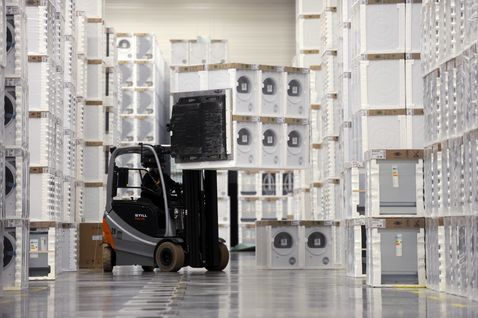i4.0 Monitoring System for Better Utilization of Warehouse Forklift Fleet
This project took place in winter term 2020, you CAN NOT apply to this project anymore!
- Sponsored by: Bosch und Siemens Hausgeräte BSH
- Project Lead: Dr. Ricardo Acevedo Cabra
- Scientific Lead: Dr. Olga Bergmeier, MSc. Eduard Bitter, M.Sc. Polat Utku Kayrak
- TUM Co-Mentor: PhD candidate Tim Fuchs
- Term: Winter semester 2020
Results of this project are explained in detail in the final documentation and presentation.

BSH (Bosch and Siemens Home Appliances Group) is one of the leading manufacturers of home appliances with 40 factories worldwide. BSH Factory in Cerkezköy in Turkey is the biggest production site and warehouse for serving East European and Middle Eastern markets.
Fluctuation in warehouse productivity and constantly increasing cost of machinery maintenance present new challenges to production and logistics managers in Cerkezköy seeking to increase profitability. Depending on the season and the time of the day, logistics managers often observe a low utilization of the forklifts in the goods issue area, with, for instance, only 60% of the fleet allocated to transportation orders and the remaining 40% staying idle. Reduction of the fleet size, on the other hand, would lead to bottlenecks, as ‘idle’ periods might be followed by ‘high peaks’ that also need to be covered.
To optimize resource allocation and gain a better control of machinery usage, camera-based tracking devices were installed within the warehouse to allow real-time monitoring of forklift routes as well as material flow through the halls. Each forklift that needs to be tracked was equipped with ID markers in order to collect different types of information, including the forklifts’ physical location, drive and idle time, driving speed and loading status. This information is very valuable for getting full real-time visibility of the forklift fleet, however, a better understanding is needed on how to minimize the idle time of forklifts and improve the overall fleet utilization.
Goal: Within this project we would like to
(1) get key- insights on root-causes for inefficient utilization of forklift fleet based on the historical data with respect to several warehouse KPIs
(2) Develop a model for dynamic prediction of the optimal fleet size based on the seasonal priority and critical demand parameters
The developed model will constitute the core of the monitoring system for forklift fleet utilization to support monthly and daily planning. Therefore, it is important to evaluate the applicability of the proposed algorithms to the real warehouse domain and propose measures on how to improve the trained models to perform well when deployed real-time in the warehouse environment.
Throughout this project,
- you will learn how to analyze the forklift sensor data (both real-time and historical) and combine it with other enterprise data (e.g., demand planning, sales orders, warehouse management operations) to extract valuable insights out of it
- you will learn about the logistic processes in one of the biggest logistics center in the East European region
- you will get an opportunity to propose and implement a model to optimize forklift fleet utilization
- you can decide yourself on the method and direction you want to go (e.g., multi-objective optimization, agent-based simulation (Monte Carlo), Deep Reinforcement Learning etc.)
- you will get all the necessary infrastructure (preferred programming languages: Python, Spark)
- Finally, you will get a chance to become involved in the deployment of the proposed algorithm to production as part of implementation of the forklift monitoring system